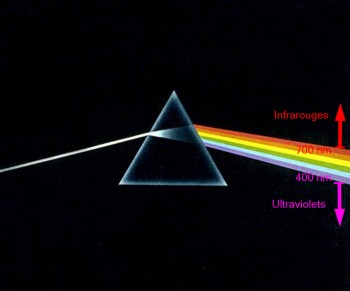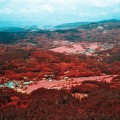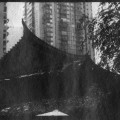Here's a curiosity rediscovered at a ranking of photos; I make you share even if since the writing of this presentation, many films that I quote became (almost) not found.
The infrared photo, Why do ?
Initially, infrared films were intended for scientific applications, but photographers seized to achieve special effects. Images will surely some surprises to the development, as the topic lends itself: You can either take a completely original look at a mundane theme (landscapes...) or already go a unusual topic. To select, should bear in mind the effects produced by the infrared shooting:
- NB, the images are grainy, shades are very clear, as in a dream… In color, the shades are completely processed.
- An outdoor stage by weather including foliage and grass will look like a snowy landscape because the chlorophyll in plants reflects the infrared rays. However, No plant returns them in the same way, which will result in different tones.
- Sand, clouds and people will also appear very clear, because they reflect them as infrared radiation.
- Water will come out bright or dark, Depending on the objects that will reflect.
- A clear sky will appear very deep black because it does not reflect infrared
The effect is all the more marked when the sun is strong.
A bit of physics
The color of light is determined by its wavelength in nanometers (NM), the visible area by human eyes extends up to about 700 NM. Between 700 and 800 NM, talking about near-infrared, then infrared beyond 800 NM.
Movies
This is where it gets more complicated, the “end” the Silver went through there, and number of references are no longer produced, If some fairly confidential liked. I remember having written the first draft of this paper during my high school years, and the Kodak HIE was still produced and available for the not very modest sum of around 18 € per film. You can now try his luck on Ebay, but prices soar quickly…
In memoriam : Kodak HIE (High Speed Infrared)
It was the movie to the highest sensitivity and sensitive as far in the infrared spectrum (up to 900 NM against approximately 650 NM for a movie&Classic B). Support is thinner than those of the other films, because there no anti-halo layer. The graininess is very apparent (similar to a Tmax 3200).
- Usable filters: all. The absence of 89 (b), a red filter is used 25, knowing that the effect is all the more remarkable that the filter is dark.
- Handling : IMPORTANT : The film should be handled, including the loading and unloading of the unit, in the BLACK FULL, under penalty of the totality of the film (at this price it would be a pity…). Indeed, the band led light and fiber optics, and the lips felt let infrared rays. If you want to keep your movie, It should be put in the fridge (and even in the freezer).
- Exhibition : ISO index of the film varies depending on conditions of sunshine and the filter used. In summer, full day, can be measured at 200 ISO (for a 89B filter) or 400 ISO (for a red filter) without filter and then back to shooting. For other situations, as at the end of day or winter, will be based on a sensitivity of 100 or 64, or even 50 ISO if the light is low.
- Focus : Since the wavelength of the collected light is not the same as normal, the focus will be shifted. Some objectives were on the focus ring a coordinate system “R” or a red dot. In this case, It does so : disengage the autofocus, make the focus manually, shift focus to the mark “R” or the red dot. A simpler solution is to choose a low aperture to compensate this gap by a large depth of field. Finally, some objectives require no offset in infrared photography.
- Development: the treatment of this film is the same as for a standard movie, Unlike need to seek initiation in black.
In memoriam : MACO IR 820
Technically the closest of Kodak HIE, its production has also broken but it is easily found on Ebay (around €20 the film still). It is handled in full black.
Ilford SFX 200
- Features: sensitive film to about 750nm (so near-infrared). It features an anti-halo layer, like the other films. Its grain is relatively fine. Available in formats 135 and 120.
- Usable filters: until the 89 (b).
- Exhibition : Ilford SFX 200 is given for ISO 200, but consider the coefficient of the filter (i.e. a real sensitivity of 25ISO with a dark red filter).
- Handling: This film can be loaded and unloaded on the day.
- Price: about € 8 coil.
Rollei IR400
Also a near-infrared film, similar to the SFX200
In Memoriam : Kodak Ektachrome Infrared EIR: the only film infrared color
- Features: colour slide film, sensitive up to 900 NM. Its grain is apparent. The rendering is in “false color” and varies depending on the employee filter. It is also possible to develop treatment crossed to accentuate the effect.
- Handling: As the HIE, the film must be loaded and unloaded in the BLACK FULL.
- Usable filter: Kodak recommends using a filter yellow n ° 12.
- Exhibition: The sensitivity of the film is 200 ISO with E-6 standard development.
- Price: Astronomical !
Necessary equipment: filters
- Yellow n ° 12: to use on the EIR, virtually no effect on the NB films.
- Red n ° 25: Blocks up to ≈ 580nm. Used on the HIE, It produces a rather marked effect; with a near infrared film, its effect is similar to that produced on a classic NB film.
- Dark red n ° 29: Blocks up to ≈ 600 NM. Greater effect than with n ° 25
- Very dark red 89 (b): Blocks up to ≈700 nm. The effect is more spectacular than with a red filter, but it is hard to aim through and its coefficient is important.
- Infrared 87 and 87 c: Blocks up to ≈ 800 NM for the 87 and 850 NM for the 87 c. The most striking effect; usable only with the HIE.
And digital ?
The sensors are sensitive to infrared radiation. It is therefore possible to hang pictures using a filter 25 or 89 (b) and selecting the BW mode. Unfortunately, some sensors have "slanted" for reasons of color rendering; This will entail long and therefore exposure time the use of a tripod.


